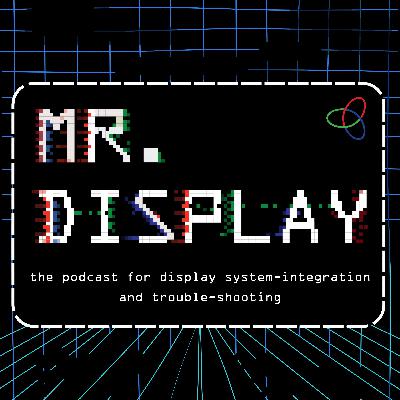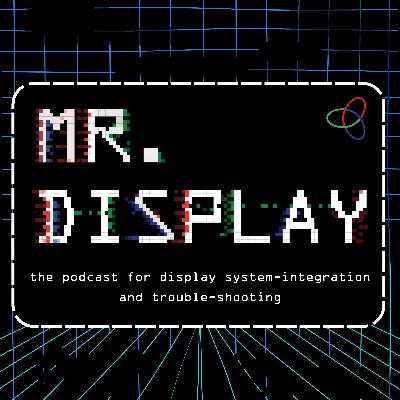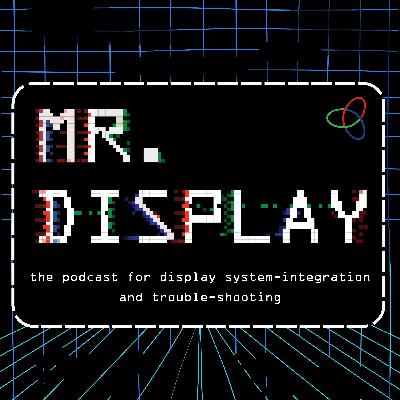Discover Mr. Display - display system-integration & trouble-shooting
Mr. Display - display system-integration & trouble-shooting

Mr. Display - display system-integration & trouble-shooting
Author: Klaus Wammes & Fabian Schütze
Subscribed: 3Played: 35Subscribe
Share
Description
Welcome to our podcast, where we delve into the world of electronic displays with Klaus Wammes, the CEO of Wammes & Partner GmbH.
With over 30 years of experience,, Klaus has been developing electronic displays and display systems for all applications, including the manufacturing of custom electronic displays and display systems for extreme applications based on various technologies and his own patents.
Over time, Wammes & Partner GmbH has evolved into a scientific service provider specializing in electronic displays. As the complexity of the field has increased and local, deep display know-how has become less available, the company’s core business has emerged: From troubleshooting and bug fixing, to error analysis and material procurement, to consulting and training for electronic displays and display systems (B2B).
Join us as we explore the intricacies of display technology, discuss the challenges faced in the industry, and learn from the expertise of Klaus and other experts.
With over 30 years of experience,, Klaus has been developing electronic displays and display systems for all applications, including the manufacturing of custom electronic displays and display systems for extreme applications based on various technologies and his own patents.
Over time, Wammes & Partner GmbH has evolved into a scientific service provider specializing in electronic displays. As the complexity of the field has increased and local, deep display know-how has become less available, the company’s core business has emerged: From troubleshooting and bug fixing, to error analysis and material procurement, to consulting and training for electronic displays and display systems (B2B).
Join us as we explore the intricacies of display technology, discuss the challenges faced in the industry, and learn from the expertise of Klaus and other experts.
23 Episodes
Reverse
Tune in to our latest podcast episode featuring Klaus Wammes, an optoelectronic display expert, as he dives into the exciting advancements in AI within the realm of display system integration. Klaus and Fabian explore the transformative potential of AI, discussing how it can empower DFF members by leveraging 25 years of collected knowledge.
Discover how a customized AI tool, developed in collaboration with a spinoff from the University of Bonn, is set to revolutionize the industry. Klaus shares insights on the importance of data security, the challenges of refining AI systems, and the practical applications that can enhance efficiency and knowledge transfer.
Learn about the meticulous process of developing this AI tool, the significance of maintaining an enclosed environment for data, and the innovative approach to making AI a practical, user-friendly tool. Klaus also addresses common misconceptions about AI, emphasizing its role as a powerful yet realistic tool in a B2B context.
Join us as we dive into the fascinating world of optoelectronic displays with expert Klaus Wammes! Discover how his company leverages cutting-edge "low-level AI" to revolutionize troubleshooting and decision-making in display system integration. 🌟
In this episode, Klaus shares insights on:
- The practical applications of AI in analyzing and validating third-party reports.
- How their AI, trained with 30 years of data, enhances service efficiency and cost-effectiveness.
- Real-world scenarios where AI helps value-added resellers and manufacturers resolve display issues.
- The importance of human input in utilizing AI tools effectively.
Don't miss this exclusive look at how AI is transforming the industry, available only to our podcast listeners!
Tune in now to learn more about the powerful tools shaping the future of display technology.
Join us as we dive into the world of optoelectronic displays with expert Klaus Wammes. In this episode, Klaus unravels the complexities of troubleshooting display systems, from identifying real trouble to managing intricate supply chains. Discover how different applications face unique challenges and learn about the importance of transparency in resolving issues.
Klaus shares fascinating insights into the financial and technical aspects of troubleshooting, highlighting the role of NDAs and the investigative process. He also discusses the "aha" moments customers experience when they realize the extent of the supply chain and the hidden complexities behind their products.
Whether it's dealing with outdoor post boxes or indoor shop displays, Klaus explains how his team uncovers the truth, guided by the principles of physics. Tune in to hear about the detective work involved in ensuring the promised functionality of display units and the critical role of evidence in making informed decisions.
Spring has sprung, and so has our latest episode! Join us as we dive into the world of display troubleshooting with optoelectronic display expert, Klaus Wammes.
Klaus shares his extensive experience in manufacturing and integrating displays, revealing the complexities behind what seems like simple components. Discover how troubleshooting in the display industry involves a holistic approach, considering everything from materials and environments to usage profiles and system integration.
Using analogies and real-world examples, Klaus explains why treating displays as mere mechanical blocks can lead to unexpected issues, and how his unique position allows him to solve these problems effectively.
Tune in to learn about the interdisciplinary knowledge required for effective troubleshooting and why Klaus is affectionately known as "Doctor Display." Don't miss this enlightening discussion that promises to bring some sunshine into your day! ☀️
Join us as optoelectronic display expert Klaus Wammes delves into the fascinating world of display system integration.
In this episode, Klaus sheds light on the concept of "trigger points"—sensors that detect when a display operates outside its specified parameters, such as temperature. These trigger points are crucial for troubleshooting, providing detailed insights into display malfunctions. But what happens when displays lack these sensors?
Klaus walks us through his meticulous approach to troubleshooting, starting from scratch with thorough inspections and documentation. He shares his expertise in using various tools, including microscopes, and emphasizes the importance of non-destructive methods to preserve the display's original condition. Klaus also highlights the use of all senses, including smell, to gather valuable clues.
The conversation explores the role of artificial intelligence (AI) in analyzing visual data, the challenges of relying on second-hand information, and the practical aspects of Klaus's work. He discusses how the depth of analysis depends on the complexity of the issue and the willingness of all parties to communicate openly. Advanced techniques like gas chromatography and ion scanning are sometimes employed, but Klaus's goal is always to provide clear and convincing evidence that everyone can agree on.
In the final segment, Klaus addresses the challenge of identifying the root cause of a malfunction with limited samples. He explains how experience plays a crucial role in filling gaps and determining common causes, even with a single sample.
Tune in to gain valuable insights from Klaus Wammes and learn about the intricate process of display system troubleshooting. Don't miss this enlightening episode! 🎧✨
Join display expert Klaus Wammes as he explores the complexities of display technology and the challenges of bringing plans to reality.
From design to deployment, Klaus shares his insights on how to troubleshoot and resolve issues with displays, and discusses the importance of collaboration, testing, and trigger points in ensuring reliable operation.
Whether you're a manufacturer, distributor, or user of displays, this podcast is for you. Tune in to learn from Klaus' expertise and gain a deeper understanding of the display industry.
In this episode of "Mr. Display: The Podcast for Display System Integration," Klaus Wammes, an expert in electronic displays, explores the complex challenges of managing different environments that displays encounter throughout their lifecycle. From production in clean rooms to transportation, installation, and potential reuse or recycling, Klaus provides a comprehensive overview of how environmental factors impact display performance and longevity.
Klaus discusses the importance of tailored thermal management solutions for different environments, such as outdoor settings with direct sunlight and indoor locations with controlled climates. He emphasizes the need for thorough testing, clear documentation, and creating evidence to prove proper usage, which can prevent legal issues and ensure customer satisfaction.
Join us for this insightful episode as Klaus shares practical examples and valuable advice on navigating the environmental challenges in display system integration, offering essential guidance for professionals in the field.
In this episode, we sit down with Klaus Wammes, a renowned expert in electronic displays, to explore the critical aspects of thermal management in display systems. Klaus explains the concepts of hot spots and cold spots—localized areas where temperatures significantly differ from their surroundings—and their impact on the performance and longevity of displays.
Klaus shares practical examples, such as the heat generated by LEDs in backlights and the cold spots caused by mounting screws transferring external temperatures. He discusses the importance of identifying and managing these spots during the design phase to prevent potential failures. Klaus also highlights various strategies for effective thermal management, including the use of fans, thermal pads, and heat sinks.
Tune in to gain valuable insights into the challenges and solutions for maintaining optimal temperature conditions in electronic displays, ensuring their reliability and durability over time. Whether you're a professional in the field or simply curious about display technology, this episode offers a deep dive into the nuances of thermal management.
In this episode, we explore the critical role of thermal management and thermal design in display systems.
Klaus explains how temperature variations impact material properties and the importance of managing both internal and external heat sources. We discuss the challenges of avoiding hot and cold spots, the necessity of buffer zones, and the complexities of selecting the right materials for effective thermal management. Join us as we delve into the intricacies of maintaining optimal performance and reliability in display systems through meticulous thermal design.
In this episode, we delve into the critical importance of facts in display system integration.
Klaus discusses the concept of optical bonding, the challenges of matching different materials, and the necessity of buffer zones to manage thermal expansion.
We explore how the physical properties of materials like glass, plastic, and metals impact the integrity of display systems and why understanding these hard facts is essential for troubleshooting and ensuring long-term reliability. Join us as we navigate the complexities of material science and its practical applications in the real world.
In this episode, we reflect on the challenges and opportunities of 2024, focusing on the increasing market volatility and its impact on businesses.
We discuss the rising demand for troubleshooting services and the critical shortage of skilled professionals. As companies face economic pressures, the need to secure and transfer knowledge becomes paramount.
We explore strategies for managing these challenges, including leveraging new technologies and maintaining a long-term vision. Join us as we delve into the complexities of the modern business landscape and look ahead to what 2025 might bring.
In this episode of Mr. Display, Klaus dives into the world of destructive analysis in display technology.
He explains the careful methods used to dismantle displays without disrupting the original issue, and contrasts “silly” destructive methods (like smashing with a hammer) with smarter approaches that maintain the product's integrity for analysis.
Tune in to learn why understanding the root cause in display troubleshooting sometimes means breaking things—but doing so with precision.
In this episode of Mr. Display, we explore the world of troubleshooting in display systems with Klaus, focusing on the nuances of non-destructive testing methods. Klaus breaks down the steps of analyzing display issues without damaging components, discussing both the traditional destructive approach and the preferred non-destructive techniques that allow multiple tests without altering the original display. Klaus explains the importance of data collection, advanced sensors, and even AI in detecting subtle issues that aren’t visible to the naked eye. For those responsible for quality control and troubleshooting in display technology, this episode provides valuable insights into evolving industry practices.
In this episode of Mr. Display, Klaus Wammes and Fabian Schütze delve into the evolving role of AI in display troubleshooting and system integration.
Klaus shares insights from his early days experimenting with "expert systems" to the full-scale, data-driven AI applications used in his company today. They discuss how AI accelerates problem-solving, allowing complex analyses that were previously too time-intensive or costly.
The conversation also explores practical challenges, like data security and non-destructive testing, and future possibilities with "AI in a can" for customized, client-specific troubleshooting solutions.
Tune in to learn about how AI as a powerful tool is reshaping industry standards and enabling faster, more precise diagnostics, while still leaving room for human expertise.
In this episode of Mr. Display, Klaus tackles a question central to the display and wider technology industry: does better quality always mean higher costs?
Together, we explore how smart strategies can improve quality without increasing expenses, drawing on real-world examples like BYD’s innovative approach to reducing system complexity. Klaus dives into how companies can use AI and intelligent integration to simplify production, reduce interfaces, and streamline functionality, all without sacrificing quality.
Listen in to learn how balancing cost, quality, and efficiency can transform production in display technology and beyond.
In this episode of Mr. Display, Klaus Wammes and Fabian Schütze delve into the intricate process of troubleshooting display systems. Building on their previous discussion of complexity in display design, they now turn their attention to what happens when things go wrong. From misaligned expectations to genuine technical malfunctions, troubleshooting is often a complex endeavor that requires clear communication, deep understanding of system integration, and the ability to diagnose issues through non-destructive methods.
The hosts discuss real-world scenarios, such as post boxes and vending machines, where displays may not perform as expected and how the process of troubleshooting starts with understanding the context. They highlight the importance of hands-on investigation, the use of video or images to better diagnose issues, and how artificial intelligence is starting to assist in organizing data and enhancing the analysis of complex systems. The episode also touches on recurring issues like poor grounding and improper optical bonding, which remain common troubleshooting themes in display technology.
This episode offers practical insights for anyone responsible for display systems, whether you're dealing with everyday malfunctions or more sophisticated technical issues.
In this episode of Mr. Display, we delve into the intricate challenges of designing and maintaining displays for use in harsh environments. Klaus Wammes and Fabian Schütze explore real-world examples, such as post boxes and vending machines, to demonstrate how factors like weather, temperature fluctuations, condensation, and user interactions impact display functionality over time.
They discuss the importance of system integration, highlighting how display systems must be tailored to their surroundings to ensure reliability and longevity. Klaus also provides insights into how system designers can anticipate and address potential issues, from condensation and overheating to mechanical stress, by considering displays as part of a larger system.
Whether it's designing a display for a post box subjected to extreme temperatures or a colorful vending machine display, this episode breaks down the practical challenges of complexity and offers actionable advice for integrating displays into various environments.
In this episode, we explore the concept of complexity in display technology, delving into the many factors that contribute to both the design and functionality of displays.
Klaus discusses the importance of choosing the right technology — whether it's LCD, OLED, or micro-LED — and how displays are integrated into products for specific use cases. We explore the distinction between displays with "fundamental properties," like those used in mission-critical applications, and "attractive properties," which focus more on design and user experience. The conversation highlights how different environments, from medical surgeries to industrial machinery, demand different levels of reliability and performance, adding layers of complexity to the design and integration process. As technology evolves, so do user expectations, budgets, and the challenges associated with creating both functional and visually appealing displays.
Stay tuned as we unpack these complexities further in future episodes.
In this episode, we dive deep into the world of display technology with a focus on the difference between "exclamation mark" and "question mark" displays.
Klaus explains how he categorizes displays based on their functionality, reliability, and mission-critical importance. We explore real-world examples, from ocean liners to medical environments, to understand the critical nature of exclamation mark displays, which must perform flawlessly under all circumstances, versus question mark displays, which may be less essential but still serve an important role. Join us as we discuss system integration, design considerations, and the complexities of building displays for various industries.
What do you need to keep in mind when designing or troubleshooting a display?
In this episode, Klaus discusses the importance of the use case and various spider-web diagrams to help understand what needs to be done.
Furthermore, he differentiates between question mark and exclamation mark projects







